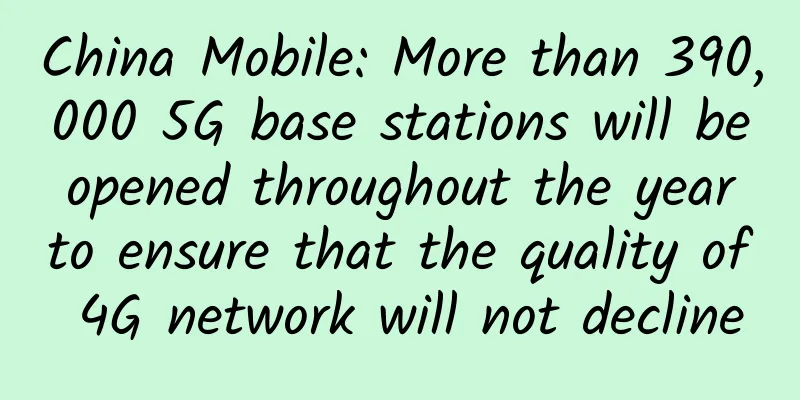The results of 5G centralized procurement have been released one after another. How to divide the “cake”?

|
As all parties continue to increase their investment in "new infrastructure", related industries are accelerating into the fast lane of development, and 5G construction is no exception. At present, operators are carrying out large-scale 5G centralized procurement, which is crucial to accelerating the overall economic scale of my country's 5G industry. In the centralized procurement of operators, how to "get as much of the pie" as possible is the answer that equipment manufacturers are eager to find. For equipment manufacturers, the "cake" of operator centralized procurement is extremely tempting. Whoever can get a larger share will not only benefit from income, but also its own industry competitiveness is expected to be further improved.
Amid the pandemic, operators’ centralized procurement kicks off the 100 billion yuan 5G construction On March 31, China Mobile released the results of its 2020 5G Phase II wireless network main equipment centralized procurement, with a procurement amount of more than 37.1 billion yuan. Previously, China Mobile announced that it would strive to build 300,000 5G base stations by the end of this year, and has now basically completed the centralized procurement of related equipment required for 5G base station construction throughout the year. In addition to China Mobile, China Unicom and China Telecom also announced the centralized prequalification announcement for the 2020 5G SA new construction project wireless main equipment joint centralized procurement project on March 10. The two parties will centrally purchase approximately 250,000 base station related equipment. So far, the three major operators have issued a total of more than 100 billion yuan in centralized procurement orders for 5G equipment. In addition, there are reports that the results of the second phase of 5G bidding by China Unicom and China Telecom will also be released in the near future. In the current context, the operators' launch of large-scale 5G equipment procurement will help expand the scale of the 5G industry in the short term, and it is very critical to reduce equipment costs and strengthen the confidence of upstream and downstream industries in the industry chain. Equipment vendors want to take advantage of 5G centralized procurement The large 5G centralized procurement orders from operators will rapidly promote the maturity of my country's 5G industry. Relying on 5G centralized procurement, upstream and downstream enterprises in the industry chain will have more development opportunities. As an important provider of operator services, although the business of equipment manufacturers is not limited to serving operators, the growth of operator business is still an important factor in the revenue growth of equipment manufacturers. Yang Guang, senior analyst at Strategy Analytics, told reporters: "Affected by the COVID-19 epidemic, the pace of 5G construction in the international market will slow down. At this time, large-scale procurement by Chinese operators is crucial to accelerating the economic scale of the 5G industry. Gaining as much market share as possible in China is also crucial for equipment manufacturers to reduce costs and enhance their competitiveness in the global market." The result of “dividing the cake”: some are happy while others are sad Since it is a "dividing the cake", there must be differences in the size of the market share. In this war without gunpowder, equipment manufacturers have made every effort to gain a larger market share. Judging from the results of the centralized procurement announced by operators recently, some are happy while others are sad. Taking China Mobile's 2020 5G Phase II wireless network main equipment centralized procurement as an example, the evaluation results show that Huawei and ZTE have obtained more than 85% of the share. The remaining share was obtained by Ericsson and China Information and Communications Technology, with a share ratio of 11.45% and 2.62% respectively. These equipment manufacturers are undoubtedly "happy". On the other hand, Nokia Bell, which did not get any in this centralized procurement, can't help but sigh. Some industry insiders believe that this means that the equipment manufacturer market may usher in a new round of changes. In response to this result, a senior telecom analyst told reporters: "In China Mobile's 2020 230,000 5G base station centralized procurement bidding, 88.54% of the market share was won by domestic manufacturers. Nokia Bell and Ericsson, which are symbols of the opening up of China's communications market to the outside world, were eliminated due to high bids and the other only obtained 11.46% of the market share. This is a major turning point for the distribution of foreign manufacturers in the Chinese communications market. You must know that in China Mobile's first large-scale 4G bidding seven years ago, the winning share ratio of Chinese and foreign manufacturers was 70:3." It can be said that the rise of domestic equipment manufacturers in recent years has changed the original operator centralized procurement market structure. Nokia Bell did not give up easily. In a recent open letter, Nokia Bell CEO Ma Boce said: "We will fully cooperate and support all operators' 5G deployment to ensure the successful construction and development of China's 5G network." Recently, there was news that Nokia Bell won the bid for centralized procurement. On April 11, China Mobile announced the centralized procurement of new SPN equipment from 2020 to 2021, involving candidates for winning bids in Inner Mongolia and Ningxia provinces. In the end, Huawei, FiberHome and Nokia Bell won the bid. For Nokia Bell, although it "missed" the chance to be included in the centralized procurement results of 26 provinces and cities announced by China Mobile, it won the bid in the last two places with a total amount of 39.18 million yuan, which can be considered a gain. After the three major operators have successively completed 5G centralized procurement, the curtain of 5G construction will be opened at an accelerated pace. 2020 will be the first year of large-scale 5G construction in my country. With the strong support of many parties, 5G will give full play to its scale effect and driving role to support the high-quality development of my country's economy. |
>>: Why don’t we have more options for in-building connectivity?
Recommend
Chinese Academy of Engineering Academician: 5G will consume 2.1% of national electricity consumption in 2026
On the afternoon of September 1st, at the "5...
The official version of PCI-E 4.0 specification is here! Bandwidth doubled again
At the Hot Chips conference, PCI-SIG said it woul...
Huawei releases MetaAAU, reducing energy consumption by 30% and improving performance and energy saving
Today, at the China (Beijing) International Infor...
Omdia: Next-generation PON equipment market to reach nearly $8.9 billion in 2025
LightReading reported that Omdia pointed out in i...
Liu Yunjie: Determinism, programmability, and cloudification will become the future network trends, comprehensively improving network service customization capabilities
At the "2020 Network 5.0 Summit", when ...
Six common IoT wireless technologies and their use cases
The Internet of Things (IoT) starts with network ...
Chinese giants retreat overseas
A withdrawal movement from Chinese giants is unde...
2017 Prediction: SD-WAN will drive the development of IoT
IoT drives SD-WAN adoption The Internet of Things...
Six ways SD-WAN simplifies network management
For software-defined wide area networks (SD-WAN),...
Paving the way for innovative applications, all-optical networks are moving from enterprises to ordinary people's homes
[[386853]] From dial-up to ADSL, and then to fibe...
Many operators have been arrested! Please stay away from these common illegal operations.
Starting from the second half of 2020, the nation...
Sharktech: 1Gbps unlimited traffic/60G high-defense server starting at $79/month, available in Los Angeles/Denver/Chicago/Netherlands data centers
Sharktech has integrated resources and updated in...
Start your digital transformation journey
[[402875]] Railways are the backbone of sustainab...
How do Huawei, ZTE and the three major operators plan for 5G?
What is 5G? 5G is the fifth generation of mobile ...
[Black Friday] Digital-vm offers 40% off, 1-10Gbps VPS in the US/Japan/Singapore and other data centers starting at $2.4 per month
Digital-vm sent an email about 40% Discount Black...









